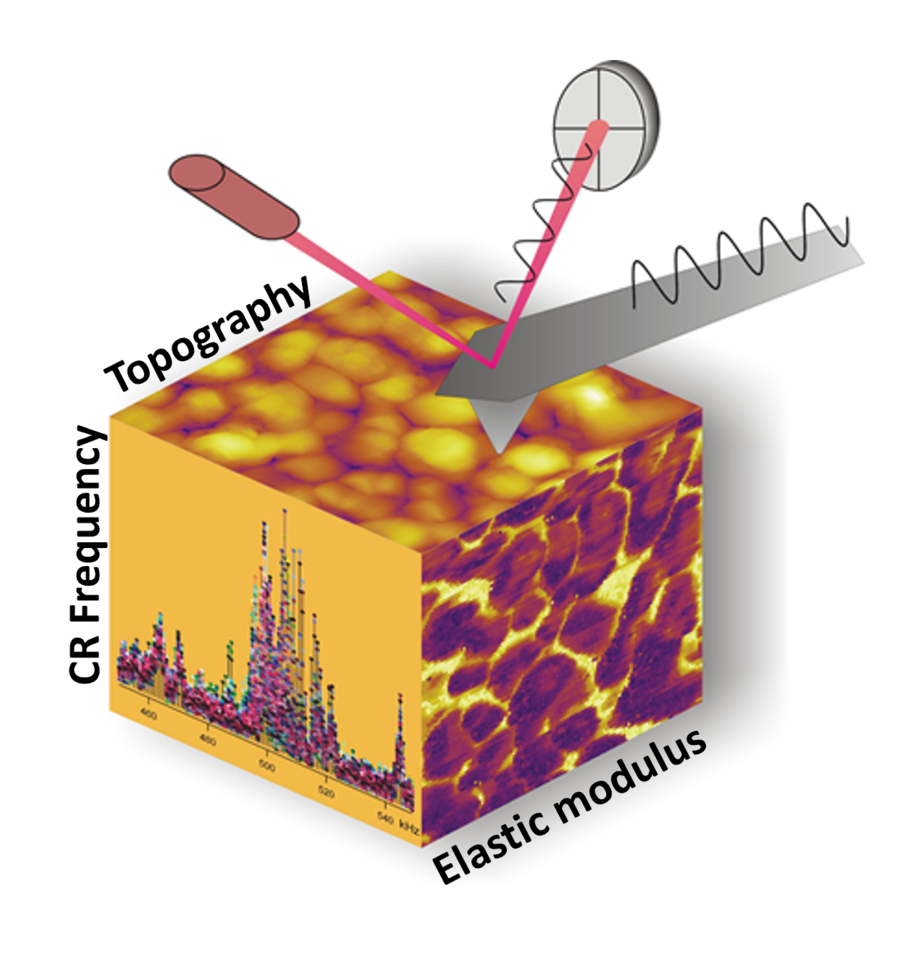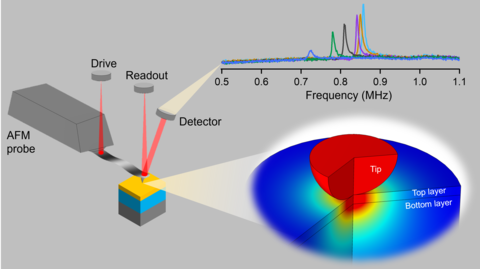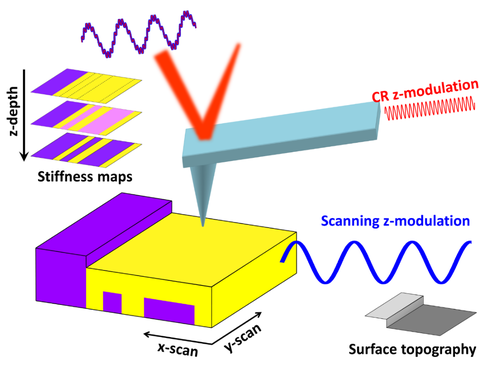Summary
Develop instrumentation, measurement methodologies, and analytical and numerical analysis for mechanical and electrical atomic force microscopy-based measurements to meet current and future needs in microelectronics and composites industries for nanoscale material characterizations. Combine different AFM techniques to probe, interrogate, and perform detailed structure-property characterization of materials and structures at the nanoscale.
- Customized AFM force-distance spectroscopies with regular and specialized probes for various nanoscale tip-sample interactions on a large range of materials from very soft (gels) to very stiff (ceramics).
- AFM-based manipulation and nanoscale mechanical tests.
- State-of-the-art Contact Resonance AFM and Intermittent Contact Resonance AFM (patent) for surface and subsurface mechanical property measurements.
- Special developments of Kelvin Probe Force Microscopy for surface potential measurements and other electrostatic interactions.
Description

Over the past several decades, Atomic Force Microscopy (AFM) has advanced from a technique used primarily for surface topography imaging to one capable of characterizing a range of chemical, mechanical, electrical, and magnetic material properties with nanometer resolution. Such characterizations significantly advanced our understanding of the morphology and composition of surfaces, interfaces, and structures at the nanoscale. For example, in semiconductor industry, AFM-based characterizations are now poised to be integrated in multistep fabrication processes, where establishing nanoscale structure-property relationships has become essential to produce controlled device functionality (e.g., electronics, sensors, and quantum devices).
In our group we primarily focus on improving and developing AFM methods for mechanical property measurements. Besides using commercially available AFM techniques for nanomechanics like Amplitude Modulation (Tapping), ForceVolume, and PeakForce Tapping we develop in-house AFM specialized modes that extend the capabilities of the ones existing on commercial AFMs. Notably, for elastic modulus measurements in the few GPa to hundreds of GPa range, we have our Contact Resonance AFM (CR-AFM) implemented in two versions, with piezo-drive and photo-thermal drive modulations. Over the years we continuously improved the quantitative CR-AFM measurements in terms of instrument developments, calibration, contact mechanics analysis, and applications on a variety of materials and structures, including but not limited to elastic properties of one-dimensional structures (nanowires, nanotubes, fibers), thin film coatings, layered materials, nanocomposites, etc. A specialized form of CR-AFM is the Intermittent Contact Resonance AFM (ICR-AFM) that performs continuous stiffness measurement as the probe is pushed in and out of contact. ICR-AFM provides a three-dimensional map (data cube) of some characteristic contact mechanics descriptors. By combining ICR-AFM measurements with contact mechanics modeling, a multidimensional image characterization can be assembled over the scanned area to reveal possible subsurface heterogeneities, defects, layered structures, etc.

In addition to specialized modes like CR-AFM and ICR-AFM, we also used common modes like Amplitude Modulation AFM (Tapping AFM), Force Volume, PeakForce Tapping, Force Modulation, and others AFM-based developments to study various nanoscale mechanical property measurements (e.g. adhesion, dissipation, viscosity, etc.). In some applications we used specialized AFM probes like colloid probes for time-dependent viscoelastic properties of soft materials like poly(ethylene) glycol (PEG) based hydrogel networks or FIB fabricated probes for direct testing of the structure-property relationship of elemental structures in additive manufacturing. Moreover, the AFM probes themselves can be used in various setups to manipulate and probe specimens in bending, fracture, and other nanoscale mechanical tests.
Mechanical property measurements can be used along with other AFM-based characterizations to expand our understanding of the morphology and properties of materials and to make advances in the fabrication of new materials and devices with desired properties and functionalities from nanoscale to macroscale. Among others, the correlation between mechanical, chemical, and electrical is the most relevant for detailing the structure-property relationship at the nanoscale. For electrical characterization we use AFM modes like Conductive AFM, Electrostatic Force Microscopy, and Kelvin Probe Force Microscopy for current measurements, current-voltage response, charge contrast, surface potential, dielectric properties, etc. Any of these modes is used either in its basic implementation or augmented by customized amplitude and frequency modulation variants.
Major Accomplishments
Intermittent Contact Resonance AFM (ICR-AFM) for sub-surface elastic property measurements

Intermittent Contact Resonance AFM (ICR-AFM) is a NIST in-house developed and patented AFM mode that adds 3D mechanical property mapping to the surface topography obtained during force-controlled intermittent-contact AFM modes. Through correlated time and frequency domain measurements, ICR-AFM provides contact stiffness and damping measurements that can be converted into 3D quantitative elastic/viscoelastic nanoscale maps. ICR-AFM extends the traditional-based 2D surface mechanical characterization to the sub-surface profiling of the material heterogeneities, structural changes, and composition. When paired with other AFM-based characterization methods, ICR-AFM offers new avenues to examine the structure-property relationship at the nanoscale.
Correlative mechanical and chemical nanoscale characterizations

We have combined ICR-AFM with atomic-force-microscopy-based infrared spectroscopy (AFM-IR) to investigate the correlations between material properties and chemical structure during the fabrication of 20 nm to 500 nm wide patterns in a nanoporous organosilicate material. We showed that by combining these two techniques (left side of the Figure), one can clearly observe variations of chemical structure (from AFM-IR) and mechanical properties (from ICR-AFM) that correlate with the fabrication process and the feature size of the organosilicate fins. Specifically, we have observed an inverse correlation between the concentration of terminal organic groups (Si-CH3) and the stiffness of nanopatterned organosilicate fins (right side of the Figure). This relationship was documented at various steps in the fabrication like plasma etching, chemical silylation, and metallization.

